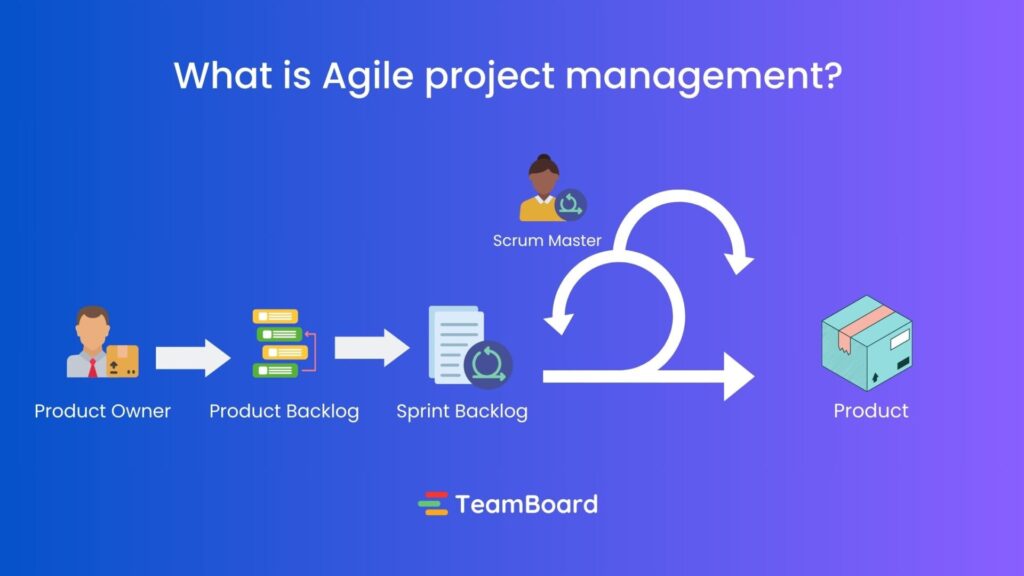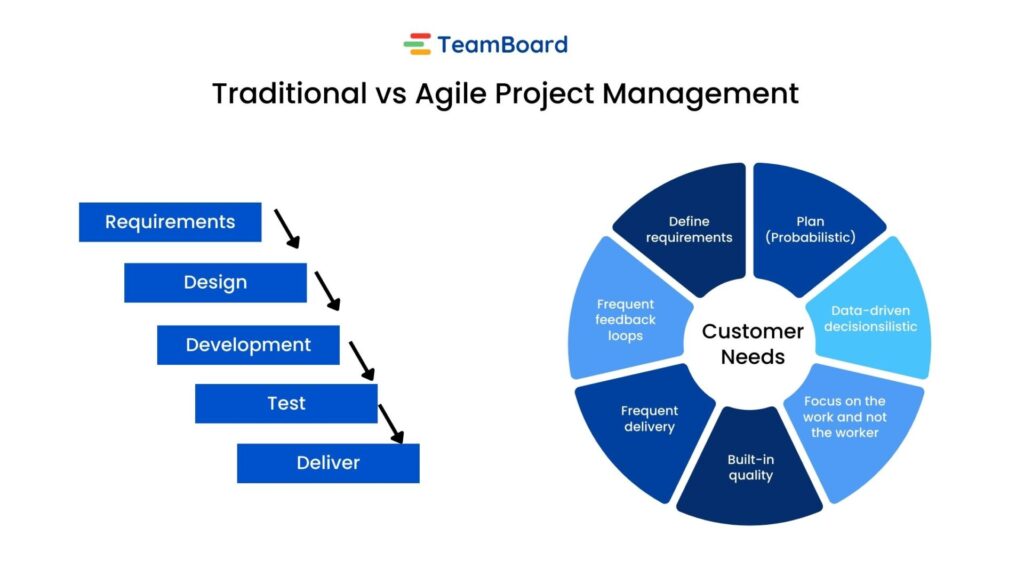Have you ever wondered why some businesses can quickly adapt to changes while others struggle? The secret often lies in the way they manage projects. Agile project management is at the heart of this adaptability. Unlike traditional methods that stick to a rigid plan, Agile embraces flexibility and rapid adjustments.
So, what exactly is Agile project management? It’s a dynamic approach where teams work in short cycles to deliver work fast and adjust easily to any changes. This blog will break down the principles of Agile, discuss its benefits, introduce the tools that facilitate this approach, and offer practical tips for success.
Table of Contents
What is agile project management?
Agile project management is a flexible methodology where teams deliver projects in small, manageable cycles known as sprints, which typically last from one to four weeks. This approach allows for quick integration of feedback and adjustments.

Consider a tech company developing a mobile app. They start with basic functionalities and, after the first sprint, demo it to the customer. Based on the feedback, they quickly incorporate a new feature in the next cycle while refining existing ones. This process of iterate, present, and refine continues, ensuring the final product is well-tuned to user expectations.
Agile is ideal for projects that face frequent changes or uncertainties, offering a stark contrast to the rigid, sequential approach of traditional methods like the waterfall model.
=> Glossary: Project Management Terms and Definitions from A-Z
Core Principles of Agile Project Management
Agile project management is not just about following a set of procedures, but it’s a mindset guided by a set of principles. These principles are foundational to the Agile philosophy and help ensure that the methodology is implemented effectively.
The Four Key Values of the Agile Manifesto:

Individuals and Interactions Over Processes and Tools:
Agile prioritizes people—both team members and customers. It emphasizes the importance of team interactions and effective communication over strict adherence to tools and processes.
Working Software Over Comprehensive Documentation:
Agile focuses on creating software that works and meets customer needs rather than getting bogged down by overly detailed documentation.
Customer Collaboration Over Contract Negotiation:
Instead of sticking rigidly to contract terms, Agile encourages ongoing collaboration with customers. This open line of communication ensures that the project evolves according to actual user needs.
Responding to Change Over Following a Plan:
While Agile projects do have plans, they are flexible and can be adjusted based on feedback and changing requirements. This adaptability is key to Agile’s success.
Supporting Principles:
- Deliver Value Early and Often: Agile teams aim to deliver small, usable portions of the product frequently, providing continuous value to stakeholders and opportunities for feedback.
- Welcome Changing Requirements: Even late in development, Agile projects are open to changes that enhance the product’s value.
- Sustainable Development: Agile promotes a consistent, sustainable pace of work, avoiding burnout and maintaining high quality.
- Continuous Improvement: Regular reflection on how to become more effective allows teams to refine their practices continuously.
Key Benefits of Agile Project Management
Agile project management offers several distinct advantages that make it a preferred choice for companies aiming to improve productivity and satisfaction. Here are the key benefits:
1. Increased Flexibility and Adaptability
Agile allows teams to adapt to changes quickly. Unlike traditional methods that might require extensive revisions, Agile’s iterative nature means changes can be integrated swiftly and efficiently, keeping projects aligned with evolving requirements.
2. Enhanced Collaboration and Communication
Regular meetings and close collaboration are central to the Agile methodology. This open communication helps resolve issues more quickly, fosters a team environment, and ensures all stakeholders are on the same page, contributing to more successful project outcomes.
3. Faster Time to Market
By breaking down projects into manageable units, Agile enables faster development and testing, reducing the overall time from project conception to delivery. This rapid turnaround is crucial in industries where market conditions and consumer preferences change quickly.
4. Higher Customer Satisfaction
Agile’s focus on customer involvement through regular feedback and iterations allows the final product to more closely align with customer needs. This continuous engagement helps ensure the product delivers real value, enhancing customer satisfaction and loyalty.
5. Improved Quality
Each iteration in Agile includes testing, which means defects are identified and fixed in real-time, rather than at the end of the project. This ongoing attention to quality results in a higher quality product at launch.
6. Efficient Problem Solving
With its regular check-ins and iterative progress, Agile facilitates early detection and resolution of issues, which can prevent them from turning into more significant problems later in the project.
7. Better Control
Through its transparency and frequent updates, Agile offers stakeholders better visibility into the project’s progress and potential issues. This enhanced oversight allows for more informed decision-making and improved project control.
Comparing Agile to Traditional Project Management
Agile and traditional project management (often exemplified by the Waterfall model) are two distinct methodologies with their own unique processes, strengths, and limitations. Understanding their differences can help organizations choose the approach that best suits their project needs.

Key Differences
1. Approach to Planning
-
- Agile: Emphasizes flexible, iterative planning and adaptation throughout the project. It allows for changes based on ongoing feedback.
- Traditional: Relies on detailed upfront planning with a fixed scope and sequence. Changes are discouraged and often require formal procedures.
2. Project Execution
-
- Agile: Divides projects into sprints or iterations, with each one delivering a potentially shippable part of the product.
- Traditional: Follows a linear sequence where the entire project is completed in one single pass, from requirements gathering to testing and deployment.
3. Stakeholder Engagement
-
- Agile: Involves stakeholders regularly throughout the project, with continuous feedback loops to ensure the product meets their needs.
- Traditional: Often limits stakeholder interaction to the requirements and delivery phases.
4. Response to Changes
-
- Agile: Welcomes and incorporates changes even late in development. This flexibility is considered a strategic advantage.
- Traditional: Changes are generally viewed as a risk and are managed through a formal change control process.
5. Delivery Timeline
-
- Agile: Produces working increments of the project regularly, allowing for early and frequent delivery to the client.
- Traditional: Typically delivers the complete project at the end, which can delay the realization of benefits until after the full product is completed.
| Aspect | Agile Project Management | Traditional Project Management (Waterfall) |
| Planning | Flexible, iterative planning allows for adapting to changes. | Detailed, upfront planning with a fixed scope and sequence. |
| Execution | Divided into sprints; focuses on delivering small increments. | Sequential execution, delivering the entire project at the end. |
| Stakeholder Engagement | Continuous collaboration and feedback throughout the project. | Limited to initial requirements gathering and final delivery. |
| Response to Change | Welcomes changes at any stage, sees them as opportunities. | Changes are managed through a formal process, often seen as risks. |
| Delivery Timeline | Frequent, incremental deliveries allow early and regular review. | One-time delivery at the end of the project, often no early testing. |
| Risk Management | Continuous assessment and adaptation reduce risks progressively. | Risks assessed primarily at the start, harder to address later. |
| Outcome | Better adaptability to changing needs, potentially higher customer satisfaction. | More predictable costs and timeline, but less flexibility. |
Common Agile Methodologies
1. Scrum
- Overview: Scrum is perhaps the most widely used of the Agile methodologies. It organizes work into fixed-length iterations called sprints, typically lasting two to four weeks. Each sprint begins with a planning meeting and ends with a review and retrospective.
- Key Roles: Scrum Master (facilitates the process), Product Owner (represents the stakeholders’ interests), and the Development Team (implements the work).
- Applications: Ideal for projects with rapidly changing or highly emergent requirements.
2. Kanban
- Overview: Kanban is focused on visualizing the entire project on a board to enhance workflow and productivity. It does not typically use sprints and allows work to be continuously released.
- Key Principles: Visualize work, limit work in progress, manage flow, make process policies explicit, and improve collaboratively.
- Applications: Best for projects that require steady output, like support and maintenance teams, or where tasks vary significantly in type and duration.
3. Extreme Programming (XP)
- Overview: XP emphasizes technical excellence with a high focus on customer satisfaction. It advocates frequent “releases” in short development cycles to improve productivity and introduce checkpoints where new customer requirements can be adopted.
- Key Practices: Pair programming, test-driven development, continuous integration, and simple designs.
- Applications: Particularly effective in projects where the software requirement changes frequently or the risk of bugs is high.
4. Lean Agile
- Overview: Originating from Lean manufacturing principles, Lean Agile focuses on maximizing value by eliminating waste (activities that do not add value). It emphasizes delivering products with fewer resources and minimal management overhead.
- Key Principles: Eliminate waste, amplify learning, decide as late as possible, deliver as fast as possible, empower the team, build integrity in, and see the whole.
- Applications: Suitable for any industry or team looking to streamline processes and increase efficiency.
5. Feature-Driven Development (FDD)
- Overview: FDD is a model-driven, short-iteration process. It focuses on delivering tangible, working software repeatedly in a timely manner.
- Key Practices: Develop an overall model, build a feature list, plan by feature, design by feature, and build by feature.
- Applications: Performs well in larger teams and in projects driven by features or specific client requirements.
Tools for Agile Project Management
1. Jira
- Overview: Users widely recognize Jira for its robust handling of issue and project tracking. It offers flexible scrum and kanban boards and integrates easily with various development tools.
- TeamBoard Enhancement: TeamBoard plugins can enhance Jira by adding visual project timelines, resource management views, and improved reporting capabilities, making it easier for teams to manage large-scale projects and maintain visibility on progress.
2. Monday.com
- Overview: Monday.com is known for its intuitive interface and customizability. It provides teams with the ability to manage workflows, track project progress, and automate routine tasks.
- TeamBoard Enhancement: With TeamBoard plugins, users can integrate enhanced analytical tools and customized views into Monday.com, which helps in better tracking of deliverables and optimizing team workflows.
=> Try TeamBoard for monday.com
3. Salesforce
- Overview: While primarily a CRM tool, Salesforce also offers capabilities that support Agile project management through its various cloud solutions that integrate sales, service, and marketing processes.
- TeamBoard Enhancement: TeamBoard plugins for Salesforce can bring additional project management functionalities, such as sprint planning and backlog management directly within the Salesforce environment, bridging the gap between sales and development teams.
=> Try TeamBoard for Salesforce
Additional Tools to Consider:
- Trello: A visual tool that uses cards and boards to manage projects and tasks, perfect for smaller teams or projects that need straightforward task management.
- Asana: Great for task breakdowns and integrates well with various communication tools, making it suitable for remote teams.
- Slack: While primarily a communication tool, Slack integrates with many Agile tools to keep teams connected, share updates, and streamline notifications.
Tips for Successful Agile Project Management
1. Embrace Change and Flexibility
- Key Insight: Agile thrives on adaptability. Encourage your team to be open to changes in project scope and requirements, viewing them as opportunities to better meet customer needs rather than as disruptions.
2. Foster Strong Communication
- Key Insight: Regular and open communication is critical. Use daily stand-ups, sprint reviews, and retrospectives to keep everyone informed and engaged. Ensure that communication channels are clear and open not only among team members but also with stakeholders.
3. Commit to Continuous Improvement
- Key Insight: After each iteration, hold retrospectives to discuss what went well and what you can improve. Use these insights to make each sprint more effective than the last.
4. Prioritize Customer Collaboration
- Key Insight: Regularly involve customers or end-users in the development process. Their feedback is invaluable in ensuring the product meets their needs and expectations. Agile emphasizes customer satisfaction and continuous delivery of valuable software.
5. Maintain a Sustainable Work Pace
- Key Insight: Avoid burnout by maintaining a consistent, sustainable pace. Agile promotes work-life balance among team members, which is crucial for long-term project success and innovation.
6. Visualize Work and Limit WIP (Work in Progress)
- Key Insight: Use tools like Kanban boards to visualize work stages and limit the amount of work in progress. This helps to focus efforts and streamline workflows, preventing overcommitment and under-delivery.
7. Empower Your Team
- Key Insight: Empower team members to make decisions and take ownership of tasks. A self-organizing team is more agile and effective, capable of adapting quickly to challenges and changes.
8. Leverage Agile Tools Effectively
- Key Insight: Utilize Agile project management tools like Jira, Trello, or Asana to track progress and manage tasks efficiently. Ensure you use the tools to enhance productivity, not as a burden or mere formalities.
9. Use Metrics Wisely
- Key Insight: Track progress with Agile metrics like velocity, sprint burn-down, and release burn-up charts to understand team performance and project status. Use these metrics to guide decisions, not to pressure the team.
Conclusion
Agile project management revolutionizes project execution, enhancing flexibility, efficiency, and customer satisfaction. Its success lies in adaptive practices and continuous stakeholder engagement, but the right tools are critical to fully leverage Agile benefits.
Enhance your Agile processes with TeamBoard. Our plugins integrate seamlessly with tools like Jira, Monday.com, and Salesforce, enriching your project management experience with better visibility and control. Elevate your Agile practice today—visit here to explore TeamBoard and start your free trial.
Related Blogs:















